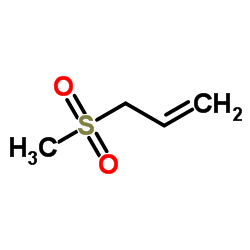Allyl methyl sulfone

Allyl methyl sulfone structure
|
Common Name | Allyl methyl sulfone | ||
|---|---|---|---|---|
| CAS Number | 16215-14-8 | Molecular Weight | 120.170 | |
| Density | 1.1±0.1 g/cm3 | Boiling Point | 244.3±19.0 °C at 760 mmHg | |
| Molecular Formula | C4H8O2S | Melting Point | N/A | |
| MSDS | Chinese USA | Flash Point | 120.3±14.2 °C | |
| Symbol |

GHS07 |
Signal Word | Warning | |
|
Detergent-type membrane fragmentation by MSI-78, MSI-367, MSI-594, and MSI-843 antimicrobial peptides and inhibition by cholesterol: a solid-state nuclear magnetic resonance study.
Biochemistry 54(10) , 1897-907, (2015) Multidrug resistance against the existing antibiotics is becoming a global threat, and any potential drug that can be designed using cationic antimicrobial peptides (AMP) could be an alternate solution to alleviate this existing problem. The mechanism of acti... |
|
|
Cardiolipin interaction with subunit c of ATP synthase: solid-state NMR characterization.
Biochim. Biophys. Acta 1848(1 Pt B) , 260-5, (2014) The interaction of lipids with subunit c from F1F0 ATP synthase is studied by biophysical methods. Subunit c from both Escherichia coli and Streptococcus pneumoniae interacts and copurifies with cardiolipin. Solid state NMR data on oligomeric rings of F0 show... |
|
|
A hydrothermal peroxo method for preparation of highly crystalline silica-titania photocatalysts.
J. Colloid. Interface Sci. 444 , 87-96, (2015) A new completely inorganic method of preparation of silica-titania photocatalyst has been described. It has been established that the addition of silica promotes crystallinity of TiO2 anatase phase. Relative crystallinity and TiO2 crystal size in the silica-t... |
|
|
Construction of porous cationic frameworks by crosslinking polyhedral oligomeric silsesquioxane units with N-heterocyclic linkers.
Sci. Rep. 5 , 11236, (2015) In fields of materials science and chemistry, ionic-type porous materials attract increasing attention due to significant ion-exchanging capacity for accessing diversified applications. Facing the fact that porous cationic materials with robust and stable fra... |
|
|
Structure-topology-property correlations of sodium phosphosilicate glasses.
J. Chem. Phys. 143 , 064510, (2015) In this work, we investigate the correlations among structure, topology, and properties in a series of sodium phosphosilicate glasses with [SiO2]/[SiO2 + P2O5] ranging from 0 to 1. The network structure is characterized by (29)Si and (31)P magic-angle spinnin... |
|
|
Thermal pretreatments of superficially porous silica particles for high-performance liquid chromatography: Surface control, structural characterization and chromatographic evaluation.
J. Chromatogr. A. 1419 , 45-57, (2015) This study reports the impact of thermal pretreatment between 400 and 1100°C on superficially porous silica particles (e.g. core-shell, fused-core; here abbreviated as SPP silica). The different thermally pretreated SPP silica (400°C, 900°C and 1100°C) were c... |
|
|
Residue-specific structures and membrane locations of pH-low insertion peptide by solid-state nuclear magnetic resonance.
Nat. Commun. 6 , 7787, (2015) The pH-low insertion peptide (pHLIP) binds to a membrane at pH 7.4 unstructured but folds across the bilayer as a transmembrane helix at pH∼6. Despite their promising applications as imaging probes and drug carriers that target cancer cells for cytoplasmic ca... |
|
|
Synthesis of a large-sized mesoporous phosphosilicate thin film through evaporation-induced polymeric micelle assembly.
Chem. Asian J. 10(1) , 183-7, (2014) A triblock copolymer, poly(styrene-b-2-vinyl pyridine-b-ethylene oxide) (PS-b-P2VP-b-PEO) was used as a soft template to synthesize large-sized mesoporous phosphosilicate thin films. The kinetically frozen PS core stabilizes the micelles. The strong interacti... |
|
|
Real-time monitoring of peptide grafting onto chitosan films using capillary electrophoresis.
Anal. Bioanal. Chem 407(9) , 2543-55, (2015) Chitosan, being antimicrobial and biocompatible, is attractive as a cell growth substrate. To improve cell attachment, arginine-glycine-aspartic acid-serine (RGDS) peptides were covalently grafted to chitosan films, through the widely used coupling agents 1-e... |
|
|
Plumbagin elicits differential proteomic responses mainly involving cell cycle, apoptosis, autophagy, and epithelial-to-mesenchymal transition pathways in human prostate cancer PC-3 and DU145 cells.
Drug Des. Devel. Ther. 9 , 349-417, (2015) Plumbagin (PLB) has exhibited a potent anticancer effect in preclinical studies, but the molecular interactome remains elusive. This study aimed to compare the quantitative proteomic responses to PLB treatment in human prostate cancer PC-3 and DU145 cells usi... |